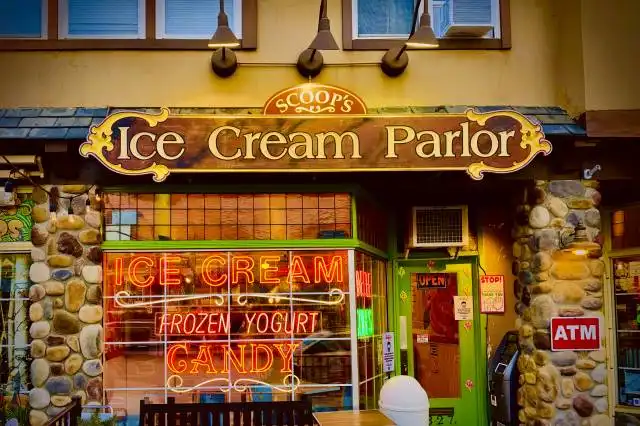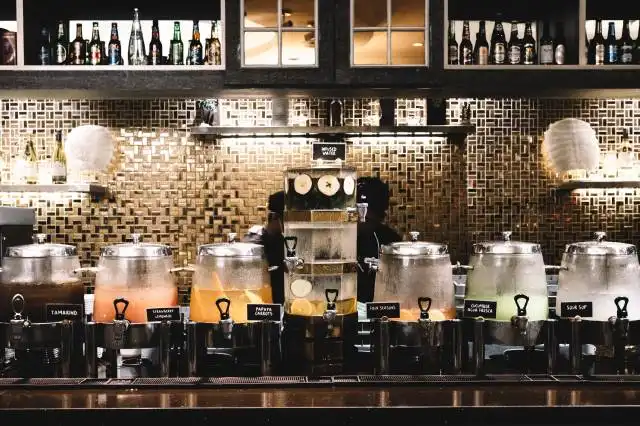Start a Beer Garden
Brewing Up A Community: The Fulfilling Journey of Starting a Beer Garden
| Updated


BEER GARDEN
Unleash your inner brewmaster and hop into a frothy venture with a Beer Garden! This bubbly business idea is all about creating an outdoor space dedicated to the service and enjoyment of beer, typically offering a variety of craft, local and international brews. As a botanical public house, you'd be not just pouring pints but fostering a community where beer enthusiasts can appreciate their ale amid greenery and good company. It's not just about sloshing amber liquids into glasses, but harvesting a unique social experience that quenches more than just thirst.
Jump to Business Plan
RELATED BUSINESS IDEAS
Browse ALL Food & Beverage Entrepreneurship Business Ideas
Discover Your Perfect Domain
Unlock the door to your online success with our hand-picked selection of premium domain names. Whether you're starting a new venture or rebranding an existing one, the right domain can set the tone for your digital presence. Browse through our curated list, each with its unique potential to enhance your brand's visibility and credibility.
BEER GARDEN MINI BUSINESS PLAN
This a quick reality check to help you identify the strengths and weaknesses of your business concept before you dive in.
Business Idea Analysis: Beer Garden
Expected Percent Margin:
- Gross Margin: 70-80%
- Hoppy beers like India Pale Ales (IPAs) have a higher cost but also attract a higher price.
- Depends on volume, pricing, and craft beer selection.
- Net Profit Margin: 10-15%
- Depends on operational efficiency and overhead costs.
Earnings Expectations:
- Daily Earnings: $1,000 - $3,000
- Weekly Earnings: $7,000 - $21,000
- Monthly Earnings: $30,000 - $90,000
- Annual Earnings: $360,000 - $1,080,000
Actions to Hit Those Numbers:
Inventory Management:
- Invest in a broad selection of craft beers to attract varied customer base.
- Set up agreements with breweries.
Marketing and Customer Acquisition:
- Implement a robust social media strategy.
- Host regular events to bring in crowds and foster a loyal clientele.
Sales and Customer Experience:
- Hire knowledgeable staff to provide a great customer experience.
- Offer a rotating selection of beers and a regular schedule of events.
Cost Control:
- Mindful purchasing and careful inventory management is critical.
- Leverage long term supplier contracts for favorable pricing conditions.
Business Operations:
- Extended operating hours - afternoons & late into the evening.
- Implement efficient service systems to maximize turnover and maintain high customer satisfaction.
It's important to remember that these are very rough estimates and can vary greatly depending on a whole host of factors including location, rent, local competition, and your ability to attract and maintain a customer base. Always conduct a detailed analysis before launching a business.
NOT WHAT YOU HAD IN MIND? Here are more ideas



Browse ALL Food & Beverage Entrepreneurship Business Ideas
Grab Your Business Website Name
Before you get caught up in the whirlwind of setting up your business, invest in a domain name. It's a small but significant step that lays the foundation for your brand and makes it easier for customers to find and trust you. Just like you wouldn't build a house without securing the land first, don't build a business without securing your domain name.
"Why? Can't that wait?" Here's why it shouldn't
Step 1: Determine if the Business is Right for You
Before starting a beer garden, it is important to determine if the business is the right endeavor for you. This includes understanding the startup and ongoing expenses associated with running a beer garden, as well as understanding the ways to make money.
Breakdown of Startup Expenses
When starting a beer garden, there are many startup expenses to consider. This includes the cost of the land or building, the cost of any renovations or repairs, the cost of furniture and decorations, the cost of any permits or licenses, and the cost of any necessary equipment. Additionally, you will need to consider the cost of any marketing materials, the cost of any staff you may need, and the cost of any insurance.
Breakdown of Ongoing Expenses
In addition to the startup expenses, you will need to consider the ongoing expenses associated with running a beer garden. This includes the cost of any supplies, the cost of any staff you may need, the cost of any utilities, the cost of any marketing materials, and the cost of any insurance. Additionally, you will need to consider the cost of any repairs or renovations, and the cost of any taxes or fees.
Examples of Ways to Make Money
When running a beer garden, there are many ways to make money. This includes selling beer, food, and other beverages, as well as charging an admission fee. Additionally, you can offer entertainment such as live music, games, or trivia nights. You can also offer merchandise such as t-shirts, hats, or mugs. Finally, you can offer special events such as beer tastings or private parties.
Step 2: Name the Business
When naming a business, it is important to choose a name that is memorable, unique, and reflects the business’s purpose. It is also important to make sure that the name is not already taken by another business. Additionally, it is important to consider the potential for a website domain name and social media handles that match the business name. When coming up with a name, brainstorm ideas with friends and family, look for inspiration from other businesses, and consider the potential for a logo and slogan.
Register the Business Name
Once the business name has been chosen, it is important to register it with the local government. This will help to protect the business name from being used by another business. Additionally, registering the business name will help to create a legal entity for the business, which will be necessary for filing taxes and other legal matters. Depending on the country, this process may involve filing paperwork with the local government, paying a fee, and waiting for approval.
Trademark the Business Name
Trademarking the business name is an important step to take to protect the business from potential legal issues. It is important to research the trademark laws in the country where the business is located, as the process may vary. Additionally, it is important to make sure that the business name is not already trademarked by another business. The process of trademarking a business name may involve filing paperwork, paying a fee, and waiting for approval.
Step 3: Obtain Necessary Licenses and Permits
Before opening a beer garden, it is important to understand the different licenses and permits that are required. Depending on the location, different licenses and permits may be needed. Generally, a business license, a liquor license, and a food service license are required. Additionally, permits for the sale of alcohol, food, and entertainment may be required.
Obtaining Licenses and Permits
The process for obtaining the necessary licenses and permits varies by location. Generally, the process involves submitting an application to the local government or state government. The application will include information about the business, such as the type of business, the location, and the owners. Once the application is approved, the business will be issued the necessary licenses and permits.
Cost of Licenses and Permits
The cost of licenses and permits varies by location. Generally, the cost of a business license is relatively low, while the cost of a liquor license can be quite expensive. Additionally, the cost of food service licenses and permits for the sale of alcohol, food, and entertainment can vary significantly. It is important to research the cost of licenses and permits in the area before starting the business.
Other Considerations
In addition to the cost of licenses and permits, there may be other considerations when obtaining the necessary licenses and permits. For example, some states may require that the business owner have a certain amount of experience in the industry or that the business owner has completed a certain amount of training. Additionally, some states may require that the business owner have a certain amount of liability insurance. It is important to research the requirements for obtaining the necessary licenses and permits before starting the business.
Step 4: Choose a Location
When choosing a location for a beer garden, there are several factors to consider. First, the location should be easily accessible to customers. It should also be in an area with a high foot traffic, such as near a popular tourist attraction or a busy shopping district. Additionally, the location should have enough space to accommodate the beer garden, including seating, tables, and other amenities. The area should also have adequate parking for customers. Finally, the location should have the necessary permits and licenses to legally operate a beer garden.
Researching Potential Locations
Once you have identified the factors to consider when choosing a location, you can begin researching potential locations. Start by researching local laws and regulations to ensure that the area is zoned for a beer garden. Additionally, research the local competition and determine if there are any other beer gardens in the area. Finally, contact the local government to inquire about any permits or licenses that may be required to operate a beer garden.
Step 5: Design the Beer Garden
When designing the beer garden, it is important to consider the space available and the type of atmosphere you want to create. Some examples of beer garden designs include:
- Traditional Beer Garden: A traditional beer garden typically has a large outdoor area with picnic tables and benches, a bar, and a large selection of beer.
- Modern Beer Garden: A modern beer garden often has a more contemporary design, with a mix of seating options, a variety of craft beers, and a variety of food options.
- Rooftop Beer Garden: A rooftop beer garden is a great option for those with limited space. This type of beer garden typically has a smaller seating area, with a bar and a selection of craft beers.
Tips for Designing the Beer Garden
When designing the beer garden, it is important to consider the space available, the type of atmosphere you want to create, and the type of customers you are looking to attract. Here are some tips for designing the beer garden:
- Consider the size and layout of the space: When designing the beer garden, it is important to consider the size and layout of the space. Make sure to plan out the seating area, the bar, and the food and beverage areas.
- Choose the right furniture: When choosing furniture for the beer garden, it is important to choose pieces that are comfortable and durable. Consider the types of customers you are looking to attract and the type of atmosphere you want to create.
- Incorporate lighting: Lighting is an important element in any beer garden. Incorporate lighting that is both functional and aesthetically pleasing. Consider incorporating string lights, lanterns, or other decorative lighting.
- Incorporate greenery: Incorporating greenery into the beer garden can help to create a more inviting atmosphere. Consider incorporating plants, trees, or shrubs into the design.
- Incorporate music: Music can help to create a more inviting atmosphere in the beer garden. Consider incorporating a sound system or live music into the design.
Step 6: Purchase Equipment
When starting a beer garden, there are certain pieces of equipment that are necessary in order to serve customers. This includes refrigerators and freezers for storing beer, a draft system for serving beer, tables and chairs for customers, and a POS system for taking payments. Additionally, depending on the size of the beer garden, it may be necessary to purchase additional equipment such as a sound system and lighting.
Where to Buy Equipment
When purchasing equipment for a beer garden, it is important to shop around for the best prices. Many restaurant supply stores offer discounted prices on equipment, and it is also possible to purchase used equipment from other businesses. Additionally, many online retailers offer discounts on bulk orders, which can help to reduce costs.
Cost of Equipment
The cost of equipment for a beer garden can vary greatly depending on the size and scope of the business. Generally speaking, the cost of equipment can range from a few hundred dollars for basic items such as refrigerators and freezers, to several thousand dollars for more complex items such as a draft system and POS system.
Financing Options
For those who are unable to purchase the necessary equipment upfront, there are a variety of financing options available. Many banks offer small business loans that can be used to purchase equipment, and some vendors offer financing options as well. Additionally, there are a number of online lenders that specialize in providing financing for small businesses.
Step 7: Hire Employees
When hiring employees for a beer garden, it is important to find individuals who are passionate about the craft beer industry and have a good knowledge of beer. It is also important to find individuals who are friendly and have good customer service skills. Additionally, it is important to find individuals who are reliable and have the ability to work well with others. It is also important to find individuals who are willing to learn and grow with the business.
Job Descriptions
When creating job descriptions for a beer garden, it is important to include the job duties and responsibilities, the desired qualifications, and the expected hours of work. Additionally, it is important to include the salary range, the benefits offered, and the expectations of the employee. It is also important to include the job title, the job location, and the job description.
Training
When training employees for a beer garden, it is important to provide training on the different types of beer, the different brewing techniques, and the different styles of beer. Additionally, it is important to provide training on the different types of glassware, the different types of food pairings, and the different types of beer-related events. It is also important to provide training on customer service, safety, and sanitation procedures.
Employee Benefits
When offering employee benefits for a beer garden, it is important to offer competitive wages, health insurance, and vacation time. Additionally, it is important to offer flexible hours, discounts on beer, and access to beer-related events. It is also important to offer employee recognition programs, such as employee of the month awards, and other incentives. Finally, it is important to provide a safe and comfortable working environment for all employees.
Step 8: Market the Beer Garden
When it comes to marketing the beer garden, there are a variety of strategies that can be used. Social media platforms such as Facebook, Twitter, and Instagram are great ways to reach potential customers. Additionally, creating a website for the beer garden and utilizing search engine optimization (SEO) can help to increase visibility. Utilizing email marketing and creating flyers or posters to hang in the local area are also great ways to market the beer garden.
Tips on How to Make the Most of Marketing Strategies
When it comes to marketing the beer garden, it is important to be consistent and creative. Utilizing all of the available platforms is a great way to reach a wide variety of potential customers. Additionally, creating content that is engaging and relevant to the beer garden is key. It is also important to use visuals such as photos and videos to help draw people in. Additionally, offering discounts or promotions can help to increase the number of customers. Finally, it is important to track the results of the marketing efforts to ensure that they are effective.
Step 9: Open the Beer Garden
Opening a beer garden can be a daunting task, but with the right preparation and research, it can be a successful endeavor. Before opening the beer garden, it is important to make sure that the business is properly licensed and insured. Additionally, it is important to have a plan for marketing the business, as well as a plan for staffing and managing the beer garden. Finally, it is important to have a plan for managing the finances of the business, including setting up a system for tracking income and expenses.
Final Preparations
Once all of the necessary preparations have been made, it is time to open the beer garden. This includes ensuring that the beer garden is properly stocked with beer and other beverages, as well as food items. Additionally, it is important to make sure that the beer garden is properly staffed with knowledgeable and friendly staff members. It is also important to make sure that the beer garden has a comfortable and inviting atmosphere, as well as a safe and secure environment. Finally, it is important to make sure that the beer garden is properly advertised and promoted, so that customers are aware of its existence and can find it easily.
EXPLORE MORE CATEGORIES
Browse ALL Business Idea Categories
TAKE THE NEXT STEPS









